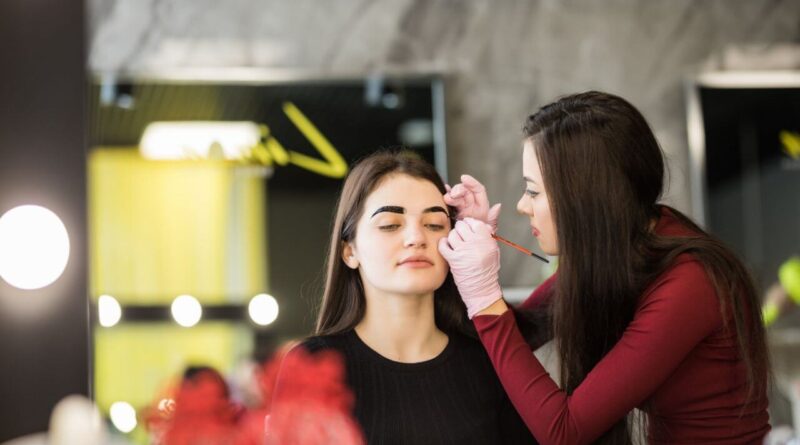How to Achieve the Perfect Makeup Look: Step-by-Step Guide
Makeup has the power to transform your appearance and boost your confidence, whether you’re heading to work or out for a night on the town. However, for many, achieving the perfect makeup look can be a challenge, especially if you’re new to the world of cosmetics. With so many products, techniques, and styles to choose from, it’s easy to get overwhelmed. That’s why we’ve created this step-by-step guide to help you achieve the perfect makeup look. Whether you prefer a natural and minimal look or a bold and dramatic one, these tips and tricks will guide you towards your desired look. So, grab your makeup bag and let’s get started!
Perfect Makeup Look: Step-by-Step Guide
Step 1: Cleanse Your Skin
Cleansing your skin is an essential step in any skincare routine, and it’s especially important before applying makeup. A clean canvas ensures that your makeup looks smooth and flawless, and helps prevent breakouts and irritation. When choosing a cleanser, look for one that suits your skin type and concerns. If you have dry skin, opt for a hydrating cleanser that won’t strip your skin of its natural oils. If you have oily or acne-prone skin, choose a cleanser with salicylic acid or benzoyl peroxide to help unclog pores and prevent breakouts. Take your time when cleansing your skin and use a gentle, circular motion to massage the cleanser into your skin, then rinse thoroughly with lukewarm water.
Step 2: Apply Toner
After cleansing, use a toner to balance the pH level of your skin and prepare it for the rest of your skincare routine. Toner is a liquid skincare product that helps to remove any residual dirt, oil, or makeup that may have been missed during the cleansing process. It also helps to balance the pH level of your skin, which can become imbalanced after cleansing with harsh soaps or cleansers. By restoring your skin’s pH balance, toner helps to prepare your skin for the rest of your skincare routine by allowing your skin to better absorb other products.
Additionally, toner can help to tighten and minimize the appearance of pores, as well as provide a refreshing and soothing sensation to the skin. There are various types of toners available, including those that are alcohol-based, water-based, or infused with natural ingredients. Choose a toner that suits your skin type and concerns, and apply it using a cotton pad or your fingertips.
Step 3: Moisturize Your Skin
Moisturizing your skin is a crucial step in any skincare routine, whether you’re wearing makeup or not. A good moisturizer helps to hydrate and nourish your skin, creating a smooth and supple base for your makeup application. It can also help to prevent your skin from becoming dry, flaky, or irritated, especially if you’re using products that can be harsh on your skin, such as makeup remover or face wash.
When choosing a moisturizer, it’s important to consider your skin type. If you have oily skin, you may want to choose a lightweight, oil-free moisturizer that won’t clog your pores. If you have dry or sensitive skin, you may want to choose a richer, more hydrating formula that can help to soothe and protect your skin. Whatever your skin type, make sure to choose a moisturizer that suits your individual needs and preferences.
Step 4: Apply Eye Cream
The delicate skin around the eyes is prone to dryness and wrinkles, making it essential to include an eye cream in your skincare routine. Applying eye cream can help to hydrate and plump up the under-eye area, reducing the appearance of fine lines and wrinkles. It can also help to reduce puffiness and dark circles, giving you a refreshed and youthful appearance. When applying eye cream, use your ring finger to gently pat it into the skin, starting from the outer corner of the eye and working inwards. Avoid pulling or tugging at the skin, as this can cause more wrinkles and fine lines to appear over time. Remember to use an eye cream that is suitable for your skin type and concerns, and to be consistent in your application to see the best results.
Step 5: Apply Lip Balm
Lip balm is an essential product in any makeup routine, especially if you want to achieve a perfect makeup look. Not only does it moisturize your lips, but it also helps to prevent them from becoming dry and chapped, which can make your lipstick look patchy and uneven. Lip balm also creates a smooth canvas for your lipstick, making it easier to apply and ensuring that it lasts longer.
When choosing a lip balm, look for one that contains hydrating ingredients like shea butter, coconut oil, or vitamin E. These ingredients help to nourish and protect your lips, leaving them soft and supple. You can also opt for a tinted lip balm to add a hint of color to your lips, or a lip balm with SPF to protect them from the sun’s harmful UV rays.
To apply lip balm, simply swipe it across your lips, making sure to cover every area. You can also use your finger to gently massage it in for added hydration. If you’re applying lipstick, wait a few minutes for the lip balm to absorb before applying your lipstick to ensure a smooth and even finish. With a little bit of lip balm, your lips will look and feel their best, completing your perfect makeup look.
Step 6: Apply Primer
A primer is an essential step in any makeup routine, as it helps to create a smooth and even base for your foundation. Not only does it help to fill in fine lines and pores, but it also extends the wear time of your foundation, keeping your makeup looking fresh and flawless throughout the day. There are different types of primers available, such as those that target specific skin concerns like redness or dullness, and those that provide added hydration or oil control. When choosing a primer, consider your skin type and concerns, and look for a formula that works well with your chosen foundation. Remember to apply your primer evenly across your face, focusing on areas that tend to get oily or have large pores.
Step 7: Apply Color Corrector
Color correcting can be a game-changer when it comes to achieving a flawless makeup look. By using the right color corrector, you can neutralize any discoloration on your skin, creating a smooth and even canvas for your foundation. If you have dark circles under your eyes, use a peach or salmon-toned color corrector to cancel out the blue or purple undertones. If you have redness on your face, such as rosacea or acne, use a green-toned color corrector to neutralize the redness. It’s important to choose a color corrector that matches your skin tone and type, and apply it sparingly with a small brush or your fingers. Remember to blend it well before applying your foundation on top for a flawless finish.
Step 8: Apply Liquid Foundation
When choosing a liquid foundation, it’s important to consider not only your skin tone but also your skin type. If you have oily skin, look for a foundation that is oil-free and has a matte finish. If you have dry skin, choose a foundation that is hydrating and provides a dewy finish. For combination skin, go for a foundation that is lightweight and balances out the different areas of your skin.
When applying your foundation, start with a small amount and build it up gradually to avoid a heavy, cakey look. Use a foundation brush or a beauty sponge to blend the product into your skin, focusing on the areas where you need more coverage. Don’t forget to blend the foundation down to your neck and chest for a seamless finish. If you prefer lighter coverage, you can mix your foundation with a moisturizer or apply it with a damp sponge for a more natural look. Remember to set your foundation with a translucent powder to keep it in place and prevent any shine.
Step 9: Apply Concealer
When applying concealer, it’s important to use the right technique to achieve a natural and flawless finish. First, apply the concealer to the areas that need coverage, such as blemishes, dark circles, or hyperpigmentation. Use a small brush or your fingertips to blend the concealer into your skin, making sure to blend out any harsh edges. If you’re using a liquid concealer, you can also use a damp beauty blender to blend it out. For an even more natural finish, apply a thin layer of foundation over the concealer and blend it out with a brush or sponge. This will help to seamlessly blend the concealer into your skin and create a smooth, even base for the rest of your makeup.
Step 10: Set Your Makeup
Setting your makeup is an essential step to achieving a flawless and long-lasting look. Translucent powder is a popular choice among makeup artists and enthusiasts because it doesn’t add any additional color to your face, making it suitable for all skin tones.
To set your makeup, take a fluffy powder brush and dip it into your translucent powder. Gently tap off any excess powder and then lightly dust it over your face, focusing on the areas where you applied foundation and concealer. This will help lock in your makeup and prevent it from creasing, smudging, or rubbing off throughout the day.
However, be careful not to apply too much powder, as it can make your skin appear cakey and dry. A light dusting is enough to set your makeup without adding any extra texture or weight to your face.
Step 11: Apply Bronzer
Bronzer is a makeup product that can add warmth and dimension to your complexion. When applied correctly, it can make your skin look healthy and radiant. To achieve a natural-looking bronzed effect, it’s important to choose the right shade of bronzer that complements your skin tone. If you have fair skin, opt for a light- to medium-toned bronzer with a peachy or pink undertone. If you have medium to deep skin, choose a medium- to dark-toned bronzer with a warm or golden undertone. When applying bronzer, use a fluffy brush to apply it to the areas where the sun would naturally hit your face, such as the forehead, cheeks, and nose. Blend it well to avoid harsh lines and create a seamless finish. Remember, a little goes a long way, so start with a light hand and build up the color gradually until you achieve your desired look.
Step 12: Apply Blush
Blush is a crucial step in achieving a natural, healthy-looking complexion. When choosing a blush shade, consider your skin tone and undertones. If you have fair skin, choose a light pink or peachy shade, while those with medium or dark skin tones can opt for deeper shades like mauve or berry. Applying blush to the apples of your cheeks will give your face a youthful, fresh look. To apply, smile and use a fluffy brush to sweep the blush onto the apples of your cheeks, then blend it out towards your temples. Remember to tap off any excess product before applying to avoid a heavy-handed application. Blush can also be layered for a more intense look or mixed with a highlighter for a radiant, glowing finish.
Step 13: Define Your Eyes
When it comes to defining your eyes, there are endless possibilities depending on your personal style and preferences. For a natural and subtle look, opt for neutral eyeshadow shades like beige, brown, or taupe. If you’re feeling more adventurous, you can experiment with bold and vibrant colors, such as blue, green, or purple.
When applying eyeshadow, start by applying a light shade all over your lid, then add a darker shade to your crease to create depth and dimension. Blend the colors together with a fluffy brush to avoid harsh lines.
When it comes to eyeliner, there are many different types to choose from, including liquid, gel, and pencil. Use a steady hand to line your upper lash line, starting from the inner corner and working your way outwards. You can create a winged eyeliner look by extending the line slightly upwards at the outer corner of your eye.
To finish off your eye makeup, apply a coat or two of mascara to your lashes. Wiggle the wand at the base of your lashes and then pull it upwards to lengthen and volumize them. You can also use an eyelash curler to curl your lashes before applying mascara for an extra boost of volume.
Remember, practice makes perfect when it comes to defining your eyes with makeup. Don’t be afraid to experiment with different techniques and products until you find what works best for you.
Step 14: Fill in Your Brows
Filling in your brows can help frame your face and make your eyes stand out. When filling in your brows, it’s important to choose a shade that matches your natural brow color and complements your skin tone. You can use a brow pencil, brow powder, or brow pomade to fill in your brows, depending on your preference and skill level.
To start, use light, feathery strokes to mimic the look of natural brow hairs. Follow the natural shape of your brows and fill in any sparse areas. If you have very sparse brows, you can use a brow gel or tint to add volume and color. Remember to blend the product well and use a spoolie brush to brush through your brows for a natural look.
It’s also important to keep your brows well-groomed by trimming any stray hairs and using a clear brow gel to hold them in place. With a little practice and patience, you can create perfectly groomed and defined brows that enhance your natural beauty.
Step 15: Apply Lipstick or Lip Gloss
Adding color to your lips is the final step in achieving the perfect makeup look, and it can make a huge difference in the overall appearance of your face. When choosing a lip color, consider your skin tone and the occasion. For a natural look, opt for a nude or light pink shade. For a bold and daring look, go for a bright red or deep berry shade. If you’re wearing a colorful outfit, a neutral or subtle lip color can balance out the look. Apply the lip color evenly to your lips, starting from the center and moving outwards towards the corners for a smooth and polished finish.
Bonus Tips:
- Use a beauty blender or makeup brush to blend your foundation, concealer, and other products for a seamless and natural finish.
- To avoid a cakey appearance, apply your makeup in thin layers and build up the coverage gradually.
- Choose makeup products that are suitable for your skin type and concerns, such as oil-free or non-comedogenic products for oily or acne-prone skin.
- Use a setting spray to lock in your makeup and prevent it from smudging or transferring throughout the day.
- When applying mascara, wiggle the wand at the base of your lashes and then sweep upwards for maximum volume and length.
- Use a lip liner to define your lips and prevent your lipstick or gloss from bleeding or feathering.
- Clean your makeup brushes and sponges regularly to avoid bacteria buildup and maintain their effectiveness.




